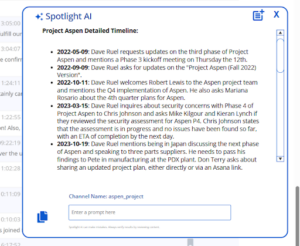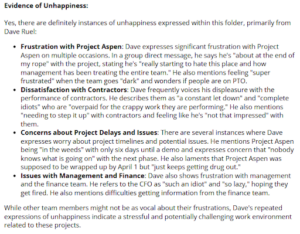
How to Handle Internal Investigations: Different Tactics for Different Triggers
Internal investigations often start small. A complaint, a suspicious transaction, or a red flag in a routine audit. Most companies try to manage these issues internally, without specialized tools or external legal support. That’s usually because it’s unclear whether the situation will escalate into litigation, and the cost of outsourcing every case isn’t realistic. In many organizations, there are dozens or even hundreds of these smaller investigations each year.
But even small cases carry serious risks. Poor handling can damage employee trust, allow systemic problems to persist, or turn a manageable issue into a legal crisis. And while every investigation is different—a discrimination complaint, a financial fraud alert, or concerns about intellectual property theft—the need is the same: a process that is fast, discreet, thorough, and defensible.
In this blog, we’ll explore how to run internal investigations across different scenarios. You’ll find practical steps, key considerations, and strategies to help your team stay consistent, proactive, and legally sound.
Laying the foundation for an effective investigation
No matter the trigger, every internal investigation needs to start on solid ground.
Act fast—and protect what matters.
Delays can mean lost evidence, fading memories, or increased regulatory risk. But speed without structure can backfire. A smart first move? Place a legal hold to preserve key data, including content that might otherwise be deleted. Modern case management tools help you move quickly and methodically—some even use AI to flag potential issues before they escalate.
Set clear boundaries.
Without clear boundaries, an investigation can quickly drift off course. Start by using AI early in the process to identify key players and surface the core issues. Then, use digital investigation tools to tag, filter, and limit access to only the relevant data, so your team stays focused and avoids veering into unrelated territory.
Keep a clean, AI-backed audit trail.
Every fact should be backed by evidence, and every step documented. Use AI-powered tools to automatically generate timeline reports that map out key events, actions, and findings. With time-stamped entries and a defensible audit trail, your investigation holds up under scrutiny: whether in court, compliance review, or internal reporting.
Stay objective.
Bias can derail an investigation faster than anything. AI tools can help reduce that risk by surfacing patterns in data without preconceived assumptions. For example, tools that use Natural Language Processing can analyze internal communications to uncover trends or inconsistencies a human reviewer might miss.
While bias can significantly hinder investigations, AI tools offer a powerful way to mitigate this risk. By identifying patterns in data without initial assumptions, AI can reveal insights that might be overlooked. For instance, Natural Language Processing tools can analyze internal communications to uncover trends or inconsistencies. It’s important to remember that AI models are trained on data, which can contain biases. However, with careful oversight and diverse training data, AI can still be a valuable asset, helping investigators to approach cases with greater objectivity and uncover hidden patterns, ultimately contributing to a more thorough and fair process.
Best Practices for the Most Common Internal Investigation Scenarios
1) Employee misconduct: Harassment, discrimination, and retaliation
When an employee files a serious complaint, whether it involves harassment, discrimination, or retaliation, the organization should respond quickly and carefully. These investigations are sensitive and demand a balance of empathy, impartiality, and procedural rigor.
The biggest risks often involve bias, breaches of confidentiality, or missteps that create legal exposure and erode employee trust.
Start by assigning a neutral investigator with no prior relationship to the people involved. This helps ensure objectivity and credibility from the outset.
Interview witnesses individually to avoid bias, but don’t go in blind. AI tools can help you build a clear timeline of key events and surface the core issues early on. They can even generate targeted interview questions based on relevant emails, chat logs, and shared documents, so you ask the right questions without tipping anyone off or compromising privacy.

Timeline created in Spotlight AI showing key updates from the Aspen project Slack channel.
Best practices to keep in mind:
- Assign an unbiased investigator
- Conduct separate interviews to preserve testimony integrity
- Use secure tools to collect communication data discreetly
- Maintain a detailed, time-stamped record of every step
Protect the privacy of everyone involved while ensuring due process
2) Financial fraud and misconduct: theft, bribery, and expense fraud
Financial misconduct investigations can be particularly sensitive, especially when they involve senior staff or significant sums of money. These cases often come with added complexity and higher stakes.
Start by using forensic accounting tools to spot anomalies: things like duplicate invoices, payments to unapproved vendors, or transactions at odd hours.
AI-driven tools don’t just cross-reference internal data with external sources like vendor watchlists, sanctions databases, or fraud patterns. They also detect sentiment shifts, unusual behavior, and hidden patterns in internal conversations, like the use of code words or sudden shifts to alternative platforms. That kind of insight can reveal risks that might otherwise stay buried.

Documented instances of employee dissatisfaction and concerns related to Project Aspen,
including commentary on contractors, project delays, and management.
If an employee becomes a suspect, any communication with them should follow secure protocols. Monitoring their digital behavior afterward is also important, as attempts to delete or alter records could indicate an effort to cover tracks.

Excerpt highlighting a potentially sensitive financial conversation
with implied secrecy and intent to delete messages.
To ensure the integrity of financial evidence, use tools that create tamper-proof, time-stamped logs. These help protect the organization if legal scrutiny follows.
Key steps to investigate and prevent financial fraud:
- Use forensic tools to flag irregularities
- Cross-reference transactions with external data for deeper insight
- Preserve records with secure, time-stamped logs
- Monitor suspect behavior for signs of data tampering or concealment
3) Intellectual property (IP) theft and departing employees
When employees leave, especially for a competitor, there’s a risk they may take sensitive information with them. Whether it’s proprietary code, customer lists, or strategic plans, acting quickly is critical to protect your intellectual property.
Start with digital forensics. Endpoint detection and response (EDR) tools help piece together what happened by tracking file access, transfers to personal devices or cloud storage, and signs of data exfiltration.
Automated log analysis can review email, file-sharing, and login activity at scale, surfacing red flags like large downloads before departure or logins at unusual times. Machine learning tools can identify patterns that suggest IP theft, even when the behavior doesn’t follow known methods.
If sensitive information was taken, AI-powered legal and compliance tools can assess the impact, preserve evidence, and support any legal or regulatory action.
Key steps during an IP theft investigation:
- Use EDR tools to track data access and movement
- Analyze activity logs for unusual behavior before and after departure
- Apply machine learning to detect subtle signs of data theft
- Automate documentation to support legal or compliance processes
4) Regulatory and compliance violations
Regulatory investigations carry extra pressure. The moment a compliance issue is uncovered, whether internally or through external inquiry, organizations need to respond quickly, with clear documentation and a careful approach.
Continuous monitoring tools can help by scanning for policy violations in real time, reducing the risk of small issues turning into major ones. These systems compare operational data against legal frameworks and flag anything that seems out of line.
When it’s time to communicate with regulators, precision matters. Automated legal review tools can help teams interpret regulatory language and draft responses that align with current laws and best practices. AI can also review contracts or internal policies to identify clauses that may have contributed to the violation.
How to manage regulatory scrutiny more effectively:
- Implement real-time monitoring to detect issues early
- Use AI to analyze contracts and policies for legal risk
- Audit internal communications for signs of regulatory gaps
- Prepare regulator-facing documents with the help of automated legal review tools
5) Whistleblower complaints
Whistleblower complaints require an especially thoughtful response. These reports often involve serious allegations and sensitive information, and the people submitting them need to know their concerns will be taken seriously, and handled confidentially.
Anonymous reporting platforms, backed by strong encryption, give whistleblowers a secure way to speak up without fear of retaliation. AI tools can assess the credibility of incoming reports by comparing them to past incidents, helping investigators prioritize cases efficiently.
After a report is submitted, tracking follow-up actions is essential. Sudden changes in a whistleblower’s role, removal from meetings, or exclusion from projects may indicate retaliation. Monitoring tools can detect these patterns and help organizations intervene early.
If the complaint ever becomes public, having a well-documented investigative trail shows that the organization handled it responsibly.
How to build a strong whistleblower response process:
- Offer secure, anonymous reporting options
- Use AI-driven tools to evaluate report content and prioritize cases
- Monitor follow-up activity for signs of retaliation
- Document each step clearly to support transparency and accountability
6) Workplace safety violations and incidents
Workplace safety is more than just a compliance issue, it’s a matter of culture and care. When something goes wrong, the response should prioritize employee well-being as much as meeting legal requirements.
If an incident does occur, automated tracking platforms can log the event, classify the risk, and recommend corrective actions. These reports are not only useful internally, but they can also be shared with regulators to demonstrate accountability and a commitment to ongoing safety improvements.
Analyzing safety trends over time helps teams identify recurring hazards and make changes before those patterns lead to more serious incidents.
Steps to manage workplace safety effectively:
- Automate incident reporting and corrective action workflows
- Keep detailed digital logs to support compliance reviews
- Analyze patterns to reduce future risks and improve safety practices
Internal investigations may start small, but mishandling them can lead to major risks. This guide shows how to use AI tools to handle issues like misconduct, fraud, or IP theft quickly, objectively, and defensibly.
How AI Tools Improve the Speed and Accuracy of Internal Investigations
Modern internal investigations are more complex than ever, spanning chat logs, financial transactions, cybersecurity incidents, whistleblower reports, and compliance audits. Manually analyzing this volume and variety of data is not only time-consuming but also increases the risk of overlooking critical evidence. AI-driven investigative tools are changing the game, enabling faster, more accurate, and more scalable investigations.
Hanzo Illuminate empowers organizations to capture, process, and search both structured and unstructured data, including rich, dynamic content from chat and collaboration platforms like Slack, Teams, Google, and others. This is especially critical as chat data becomes central to workplace communications and often contains the most candid insights into organizational behavior.
Hanzo Spotlight AI goes a step further by detecting behavioral anomalies and communication patterns that could signal misconduct, fraud, or emerging compliance risks, surfacing signals that traditional keyword searches would likely miss.
Meanwhile, Hanzo Chronicle creates a defensible, immutable record of communications and content, making it easy to audit whether what your company has published meets regulatory standards. Whether it’s investor disclaimers in financial services, healthcare benefit disclosures, or product recall notices, Chronicle helps you prove that the right message was shared at the right time, and that it hasn’t been altered after the fact.
Yet, even the most powerful AI is only as effective as the people guiding its application. Successful investigations require both advanced tools and skilled investigators who understand how to interpret context, think critically, and manage legal and ethical complexities. By integrating AI-powered insights with proven investigative methodologies, organizations can conduct thorough, defensible investigations that stand up to both internal and external scrutiny.


 Hanzo Team
Hanzo Team 
